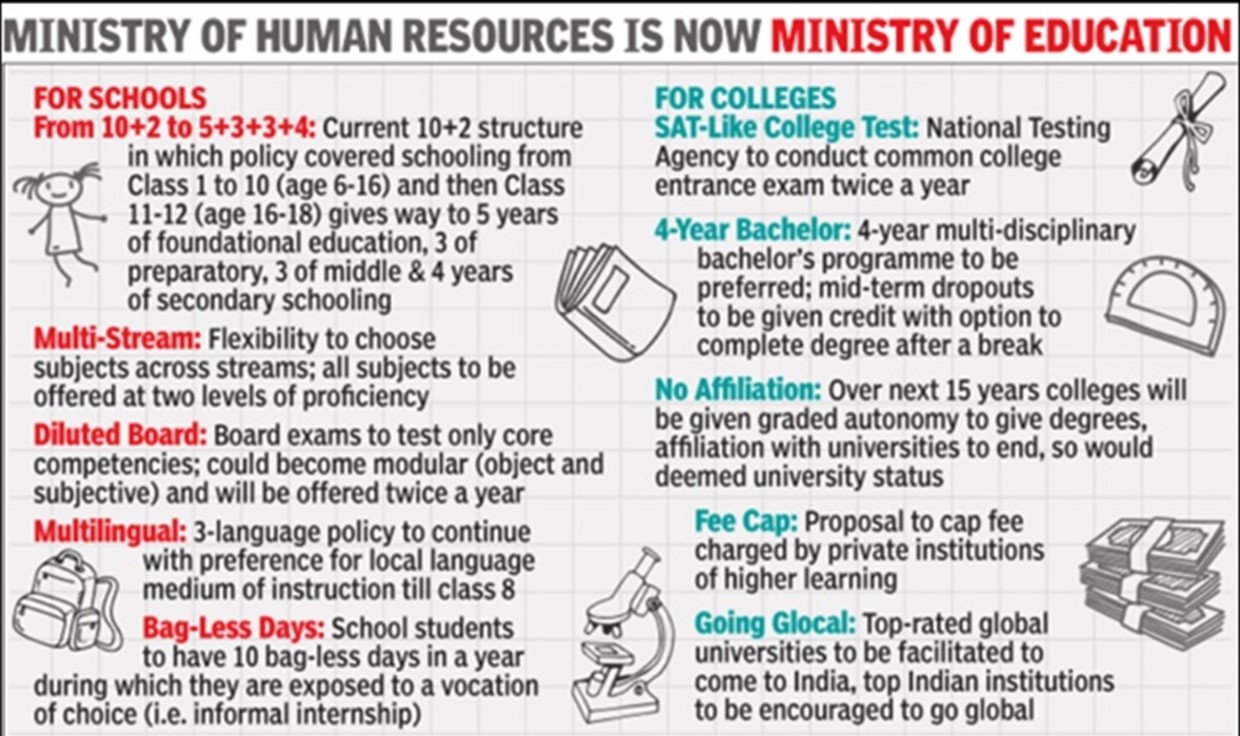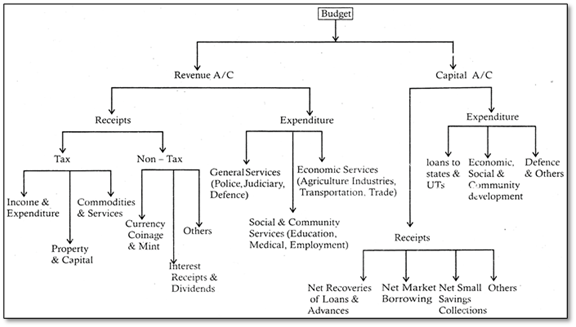Friday, 28th January 2022
Corruption Perception Index 2021
In News
The 2021 Corruption Perception Index by Transparency International places India 85th on a list of 180 countries, one position above last year.
About the Index
- The CPI ranks 180 countries and territories around the world by their perceived levels of public sector corruption based on a score from 0 to 100.
- Each country’s score is a combination of at least 3 data sources drawn from 13 different corruption surveys and assessments.

- These data sources are collected by a variety of reputable institutions, including the World Bank and the World Economic Forum.
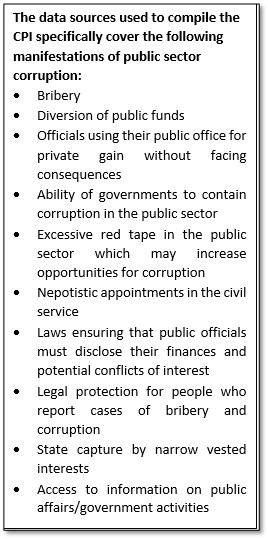
Important Findings
- Denmark, Finland and New Zealand tied at the top with a score of 88.
- This year’s Corruption Perceptions Index (CPI) reveals that corruption levels are at a worldwide standstill at 43 out of 100.
- Two-thirds of countries score below 50, indicating that they have serious corruption problems, while 27 countries are at their lowest score ever.
- Many countries have used covid pandemic as an excuse to curtail basic freedoms and side-step important checks and balances. There is a direct impact of such curtailment on the fight against corruption.
- Many high-scoring countries with relatively “clean” public sectors also continue to enable transnational corruption – with consequences for their own corruption levels.
- Transnational bribery – the most dominant form of transnational corruption, occurs when people from one country bribe public officials from another country.
- International efforts to combat Transnational Corruption:
- OECD Anti-Bribery Convention (1997): put legal constraints on multinational enterprises (MNEs) to supply bribes overseas.
- United Nations Convention Against Corruption (General Assembly resolution, 2003): requires parties to criminalize the bribery of foreign public officials.
Status of India
- India scored 40, a slight improvement from the score of 36 in 2012 and was placed 85th, a jump from 94th place in 2012, on the list.
- India was among 86% of the 180 countries the index covers that have made little to no progress since 2012.
- According to the report, although India has scored better than almost all of her neighbours, there are concerns over India's democratic status, as fundamental freedoms and institutional checks and balances decay due to curbs, slapping of charges and attacks on journalists and activists.
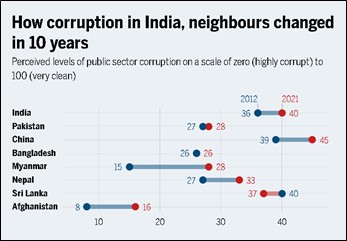
Sources:
Inheritance of Fathers' self-acquired, inherited properties by Daughters
In News
The Supreme Court has recently ruled that the daughters of a male Hindu, dying intestate (without a will) can inherit the self-acquired and other properties obtained by the father in the partition and get preference over other collateral members of the family.
About the Judgement
- The Court was dealing with the legal issue concerning the right of the daughter to inherit the self-acquired property of her father, in the absence of any other legal heir.
- Devolution of property by inheritance: If a property of a male Hindu dying intestate (without a will) is a self-acquired property or that obtained in the partition of a family property, then the same would devolve by inheritance and not by survivorship.
- Preference to the daughter: The daughter of such a male Hindu would be entitled to inherit such property in preference to other collaterals (such as sons/daughters of brothers of deceased father).

What does the Hindu Law of Succession say?
- Right of a Widow: Right of a widow or daughter to inherit the self-acquired property or share received in the partition of a coparcenary property (under the Hindu Law, coparcener indicates those male members of a Hindu family who have an undivided interest over the ancestral property by birth) of a Hindu male dying intestate is very well recognized under the Hindu Succession Law.
- The legislative intent is to remedy the limitation of a Hindu woman who could not claim an absolute interest in her inherited properties but only had a life interest in it.
- If a female Hindu dies intestate without leaving any issue, then the property inherited by her from her father or mother would go to the heirs of her father whereas the property inherited from her husband or father-in-law would go to the heirs of the husband.
- The basic aim here is to ensure that inherited property of a female Hindu dying issueless and intestate, goes back to the source.
Source:
Conditional Market Authorisation
In News
Covishield and Covaxin Covid-19 vaccines have been granted “conditional market authorisation” for the country’s adult population.
About the News
- For a year, Serum Institute and Bharat Biotech have been submitting rolling data related to product efficacy and safety in batches.
- These vaccines now meet the high standards of safety, effectiveness, and manufacturing quality required for a new vaccine under Drugs and Cosmetics Act, 1940.
- This is still not full market
What is Conditional Market Authorization?
- Conditional marketing authorization is one of the regulatory mechanisms for promoting early access to pharmaceuticals that meet an unmet medical need, such as the current pandemic
- Ministry of Health has classified conditional market authorisation as a new category of authorisation that has emerged during the Covid-19
- It was done for fast-tracked approvals with certain conditions to enhance the access to certain pharmaceuticals for meeting the emerging needs of drugs or vaccines.
- Under the conditional market authorisation vaccine manufacturers have to submit the safety and efficacy data every six months.
What will change under conditional market authorisation?
- Ordinary recipients: Vaccines would be made available in pharmacies or chemist shops for purchase — either as an over-the-counter product, or against a doctor’s prescription. However, Covishield and Covaxin will still not be available in regular pharmacies, and you will not be able to buy them as a retail product, with or without a prescription.
- Hospitals: The vaccines will be available for private hospitals and private clinics to procure though, against required documentation and payment. However, the private hospital or clinic will still have to capture it on CoWin, the government’s digital vaccination platform.
- Double-vaccinated people: The two vaccines will be supplied under “programmatic setting”, which means only those whom the government has made eligible for the precautionary dose — frontline workers, healthcare workers, and the elderly population with comorbidities — can access the third dose.
How is Conditional Market Authorization different from Emergency Use Authorisation (EUA)?
- The EUA route is approved for restricted use in emergency situations.
- It is invoked in public health emergencies like the pandemic — provided the regulator, based on initial data from phase 3 of clinical trials, determines that the potential benefits of the vaccine, when used to prevent Covid-19, outweigh its potential risks.
- Not every vaccine is granted EUA before it receives full These two vaccines have been made available under EUA, since the year 2021.
- Under “Emergency Use Authorisation” (EUA), manufacturers have to submit safety and efficacy data every 15 days or a month.
Conditional market authorisation in World
- EU: The European Medicines Agency (EMA), is tasked with the evaluation and supervision of medicinal products, grants conditional marketing authorisation if key criteria are met.
- USA & UK: The conditional market authorisation for Covishield and Covaxin is similar to the conditional market authorisation that, say, the United States Food and Drug Administration (FDA) has granted to Pfizer’s mRNA Covid-19 vaccine, or the Medicines and Healthcare products Regulatory Agency (MHRA) in the United Kingdom has granted to AstraZeneca’s Covid-19 vaccine.
Sources:
Lala Lajpat Rai
On January 28, 1865 Lala Lajpat Rai was born in the Ludhiana district of Punjab. Rai pursued his education in law and was a founding member of the Bar council of Hisar. He also founded many other organisations including the Hisar congress, Hisar Arya Samaj and was head of the Lakshmi Insurance Company. In 1928, Rai led a non-violent march against the Simon Commission set up by the British and gave the movement a slogan 'Simon Go Back'. He suffered severe injuries after police lathi-charged the protesters and died in November 1928. His ideologies and contribution in making India an independent country is what earned him the title of Punjab Kesari or the Lion of Punjab. He was a part of the triarchy political institution Lal Bal Pal, who advocated the Swadeshi movement, by boycotting all imported items and promoting the use of Indian made goods in 1907.

Source:
EU’s Global Gateway
In News
On 1 December 2021, the European Union (EU) unveiled the Global Gateway, its plan to support infrastructure development around the world.
Setting the Context: Regional Dominance via Infrastructural Connectivity
- Over the past decade, amidst China’s phenomenal economic and military growth, the world’s focus has turned to Asia, especially the Indo-Pacific. Much of this focus has been dominated by infrastructural connectivity needs.
- The idea that regional dominance will be won via infrastructural connectivity has been gaining ground since the announcement of China’s trillion-dollar Belt and Road Initiative (BRI) in 2013, which only accentuated global threat perceptions and competition.
- The rationale behind EU’s Global Gateway is clear: the world needs major infrastructure investments. The World Bank estimates that to achieve the goals of climate and environmental protection, universal access to energy, water and sanitation, greater mobility, and improved food security, the world must invest around €1.3 trillion per year in infrastructure.
Inside EU’s Global Gateway
- Global Gateway strategy aims to build resilient connections across the world. It will mobilize €300 billion in investments until 2027 “in both hard and soft infrastructure” across digital; climate and energy; transport; health; education; and research sectors.
- It is based on six principles: Democratic values and high standards; Good governance and transparency; Equal partnerships; Green and clean; Security focused; and Catalysing private sector investment.
- Global Gateway envisions boosting connections within Europe—by implementing a Team Europe approach to bring together EU member states and their financial and development organizations—and beyond, by engaging with international partner states to “promote sustainable connectivity investments.”
- It also aims to strengthen international stability and cooperation through fair democratic values.
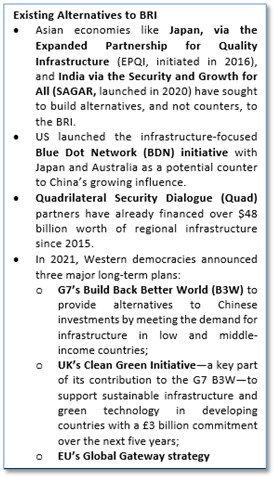
The Global Gateway Strategy through the Prism of Rising EU-China Tensions
Global Gateway strategy must be viewed in context of deteriorating relations between EU and China.
- In March 2021 the EU (alongside US, UK and Canada) imposed sanctions on four Chinese officials and a company over human rights abuses against Uyghurs in Xinjiang. China retaliated by sanctioning several individuals (including European lawmakers) and institutions.
- Soon after, EU reportedly called out China’s “authoritarian shift” under current Chinese President and acknowledged fundamental differences between their ideologies.
- In May 2021, European Parliament voted to freeze the ratification of Comprehensive Agreement on Investment (CAI) that was signed in 2020, deepening the rift in EU-China relations.
- Further, in December 2021, European Parliamentary Research Service identified the BRI as an opaque venture and presented the “rationale for a joint Western alternative to BRI.”
Challenging China within Europe and Beyond
Global Gateway is designed to counterpoise China’s $1 trillion to $8 trillion BRI, which seeks to connect Asia, Africa, and Europe via land and maritime networks.
- China has significant economic influence in Central and Eastern Europe (CEE) and the Western Balkans through investments in regional infrastructure and trade and cultural ties. Therefore, Global Gateway will first target regions in its periphery, including CEE.
- In Africa, too, the strategy will envision filling the investment gap created by China’s misguided “bigger equals better” approach. EU will discuss Global Gateway at 2022 EU-Africa Summit.
- The strategy plans for projects across the globe, competing with BRI not only in Africa and Europe (including the Arctic), but also Latin America and the Indo-Pacific.
- It is aligned with the B3W vision, the UN’s Agenda 2030, and the Paris Agreement. Thus, Global Gateway could be “a true alternative”—a unified Western response to the BRI.

Rebuilding Transatlantic Ties through Global Gateway
- The announcement of the Australia-UK-U.S. (AUKUS) security pact in September 2021 revealed the growing difference between the EU and the US.
- The deal created deep resentment in Paris (for undercutting France by abruptly canceling the Franco-Australian submarine deal) and Brussels (over secrecy and lack of consultation).
- Timing of the announcement, coinciding with the EU’s Indo-Pacific strategy, was also suspect.
- The haphazard withdrawal of NATO-US troops from Afghanistan, leading to the return of the Taliban, eroded the trust in Europe’s long-time ally, the United States.
In these scenarios, the Global Gateway strategy could accomplish a two-fold purpose: to repair the rift in transatlantic ties and continue to build strategic autonomy.
Global Gateway Factoring in EU-India Relations
- India’s growing conflict with China, its strategic evolution, and its eagerness to expand its outreach to Europe, along with the EU’s intent to reduce its reliance on Chinese manufacturing and supply chains and to pursue strategic autonomy, have created the right conditions for a new mutually beneficial policy regime.
- Involving India within an infrastructure development framework would prove lucrative—from diversifying supply chains and engaging in digital transformation to green transitions (India and France initiated the International Solar Alliance) and inclusivity in development efforts.
- As co-advocates for the involvement of low and middle-income nations within multilateral development initiatives, India could prove critical to the EU’s attempt at creating a democratic, inclusive, and link-based framework.
Global Gateway Finds Convergence with India - Possible Areas of Synergy
- India can play a crucial role in the effective implementation of the EU’s ambitious connectivity strategy through the India-EU Connectivity Partnership.
- The EU-India Connectivity Partnershipfinalized in May 2021 builds on India’s strategic partnership with the EU and will “support sustainable digital, transport and energy networks, and the flow of people, goods, services, data and capital centred on equity and inclusivity and assisting in global development efforts, based on Sustainable Development Goal principles that no one is left behind.
- Europe and India must track down ways of organizing and synergizing different public and supra-national projects by focusing on regions less infiltrated by the BRI, particularly in Eastern Europe, India, and Japan.
- In the supply chain domain, the India-Australia-Japan-led Supply Chain Resilience Initiative (SCRI) could be vital to Global Gateway, as both focus on reinforcing “the resilience of supply chains” and diversifying global supply chains to reduce dependence on China-centric supply routes.
- Further, as Global Gateway expands its geographical scope beyond the European neighborhood, it can synergize with India’s Act East Policy, the India-Japan Platform for Business Cooperation in Asia-Africa, its Connect Central Asia policy, and its Look West policy. Such cooperation can be built on the robust ties India shares with the EU, and with specific EU states such as France and Germany.
- On defense and security, too, the new strategy can help coordinate and integrate European industry to explore opportunities that are mutually beneficial. Already, India has close defense ties with several individual European countries.
- The strategy can be used to promote the development of a sustainable blue economy, as outlined in the EU-India Roadmap to 2025, and to support a green transition across the world.
- Also, the resumption of EU-India negotiations on the long-stalled FTA is likely to impact the scope for cooperation between India and Global Gateway.
Conclusion: Global Gateway is a critical European strategy, which is set to chart the next five years of the EU’s Asia—and China—outlook by focusing on building resilient connections both within Europe and beyond through “links and not dependencies.” In this respect, the Global Gateway, with its focus on limiting risks of debt distress in partner countries, seems to provide a more reliable alternative for global infrastructure development.
Question: How is Global Gateway better than BRI? Would the Global Gateway initiative help EU to reconfigure its role in the changing world order?
Sources:
"Spooky" Object In Milky Way
This is image of a strange spinning object in the Milky Way, which the scientists say is unlike anything astronomers have ever seen. The object releases a huge burst of radio energy three times every hour. The pulse comes "every 18.18 minutes, like clockwork. While there are other objects in the universe that switch on and off -- such as pulsar. But 18.18 minutes is a frequency that has never been observed before. The research team is now working to understand what they have found. The object is about 4,000 light-years from Earth, is incredibly bright and has an extremely strong magnetic field. It could also be a white dwarf, a remnant of a collapsed star. The research team was able to observe the signal across a wide range of frequencies, which means it must be a natural process, this is not an artificial signal sent by any other life form in the universe.

Source:
Ecowrap Report: SBI
- Context: The recently release Ecowrap report of the SBI has pointed at the reverse repo normalization in the current economic conditions.
- As per the report, the stage is set for a reverse repo normalisation, given that the Triparty Repo Dealing and Settlement (TREPS) and call money rates are ruling higher than the reverse repo rate.
- Normalisation means the reverse repo rate (the interest rate banks earn for parking surplus liquidity with RBI) of 3.35% can be raised to 3.75% in one or two stages.
- A Tri-Party Repo is a form of repo contract in which a third party (not the borrower or lender) acts as an intermediary between the two parties to the repo to provide services such as collateral selection, payment and settlement, custody and administration during the life of the transaction.
- The aim of Tri-party repo is to contribute to better liquidity in the corporate bond repo market, thereby providing markets an alternative repo instrument to Government securities repo.
- The interest rate on a sort of short-term loan that banks offer to brokers, who then lend the money to investors to fill margin accounts, is known as the call money rate.
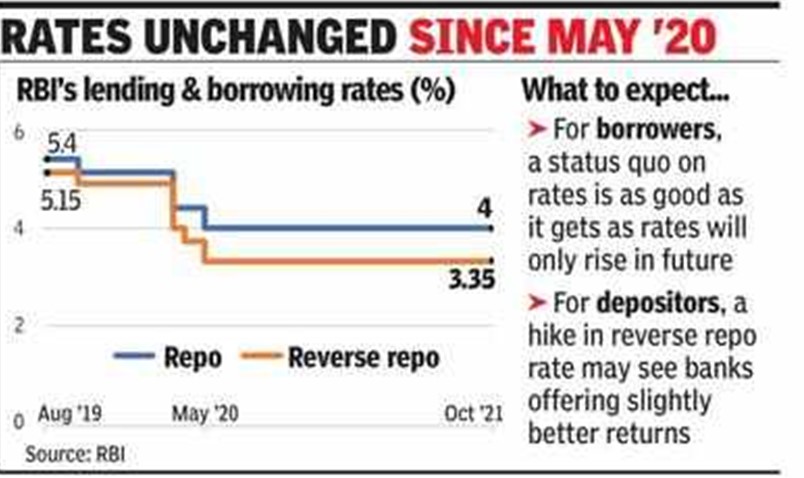
Source:
Small Satellite Launcher
- Context: ISRO’s rockets called Small Satellite Launch Vehicle (SSLV), is expected to have its maiden development flight in April 2022.
- SSLVs are ISRO’s indigenous new launch rockets designed to be a launch vehicle for tiny satellites into low earth orbit which has until now been dependent on ‘piggy-back’ rides with big satellite launches via Polar Satellite Launch Vehicle.
- The SSLV is the smallest weighing 110 tons that can carry satellites weighing up to 500 kg.
- It requires only 72 hours to deploy, as opposed to the 70 days necessary for a launch vehicle and only 6 employees as against 60.
- The project thus saves both time and cost.
- SSLV can be used to quickly replace lost satellites and also augment other space-based assets during wartime.
- Unlike the PSLV and GSLV, the SSLV can be assembled both vertically and horizontally.
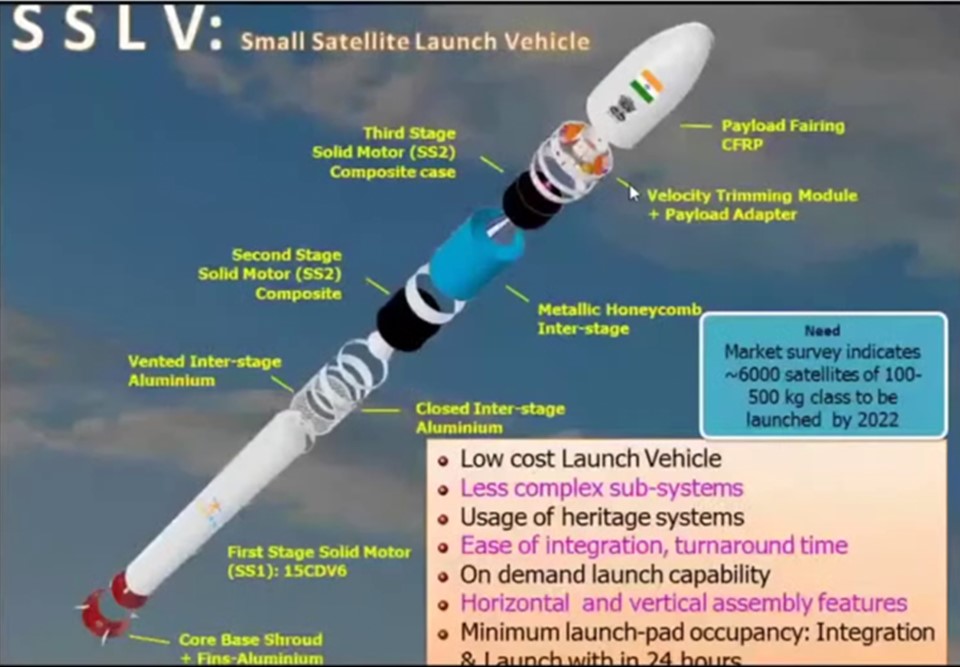
Source:
The Digital Rights and Principles
- Context: The European Commission has recently proposed a set of digital rights and principles.
- These rights are enshrined in the EU’s legal framework and aim to protect people's rights, support democracy and ensure a fair and safe online environment.
- It acts as a guide for policymakers and companies when dealing with new technologies.
- It covers digital devices, ensuring that the products sustainability and green transition goals, with details provided on their environmental impact and energy consumption.
- The declaration "establishes once and for all that what is illegal offline should also be illegal online,
- This outlines the bloc's commitment to strengthening the democratic framework for a digital transformation that benefits everyone and technological solutions that respect people's rights and promote inclusion.
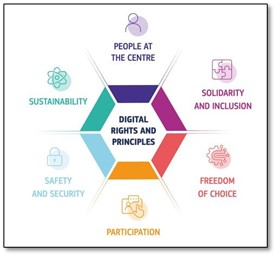
Source:
Sathyamangalam Tiger Reserve
- Context: The Sathyamangalam Tiger Reserve has recently won the TX2 award for doubling the tiger population since 2010.
- The Sathyamangalam Tiger Reserve is a protected area and a tiger reserve in the Western Ghats in Erode district of Tamil Nadu.
- The reserve is located close to the Malai Mahadeshwara Wildlife Sanctuary, an emerging tiger hotspot.
- The TX2 Tiger Conservation Award is conferred by Conservation Assured | Tiger Standards (CA|TS), Fauna & Flora International, Global Tiger Forum, IUCN Integrated Tiger Habitat Conservation Programme, Panthera, UNDP Lion’s Share, Wildlife Conservation Society, and Worldwide Fund For Nature’s (WWF’s) Tigers Alive Initiative.
- It was launched with the objective to recognize and celebrate significant progress made towards tiger recovery since 2010.
- The awards celebrate the 10-year anniversary of all 13 Tiger Range Countries committing to double the global population of wild tigers by 2022 - a goal known as TX2.
- TX2 aims at reversing the downward decline of tigers and recognizes the efforts of the government bodies, NGOs, and local communities towards tiger conservation, as these are the top predators in the ecosystem, and are vital in regulating and perpetuating ecological processes.
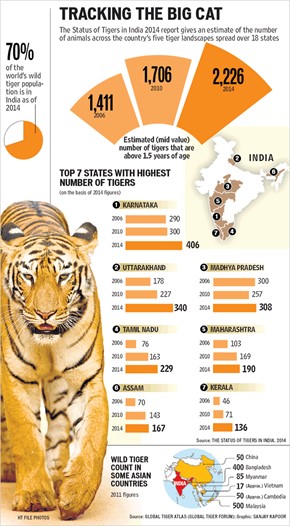
Source:
India’s economy and the challenge of informality: TH
Essence: The article talk about the large informal sector of Indian economy and the steps taken by the government to bring it into the formal ambit. Some of the international institutions blame excessive regulation and taxation for the existence of informal sector. But, it is the underdevelopment in the economy keeps a huge section of the society under the informal arena. The article highlights the different layers of informality. Informality cannot be just limited to organizations not paying taxes but also to those having low productivity and where survival is a challenge. Survival is perhaps the biggest challenge for most informal workers (and their enterprises), and precarity defines their existence.
Despite the efforts at formalisation, the challenge of informality looms large for India and he pandemic has only exacerbated this challenge. Though the efforts to remove excessive regulation are laudable but has yielded limited results. Economy will transform only when informal enterprises will get more capital investment and reskilling of workers. Mere registration on numerous portals will not solve the ultimate purpose.
Why you should read this article?
- To understand the state of informal economy in the country.
- To understand the wider steps taken by the government for their formalization.
- To understand why these steps are not sufficient in the given scenario.
- To understand what else should be done to convert India’s informal economy into formal one.
Source:
Scaling up higher education in India: HBL
Essence: According to the National Education Policy 2020, HECI would be the regulator for higher education, with four verticals. Over the last three decades, India has established a slew of statutory regulatory authorities based on existing structures. This article proposes a few high-level design characteristics that are appropriate for HCEI's job. The article discusses a few changes that could improve the efficiency of HECI's operations. Like- the full title of the Act should provide for the formation of HECI with the goals of protecting users' rights, promoting higher education development, and regulating higher education in India. To avoid regulatory overlaps and gaps, the Act should clearly define HECI's jurisdiction. The legislation should treat HECI as a separate legal entity from its Governing Commission (GC), with distinct powers and obligations for each. HECI must be self-contained in order to be accountable. It should be self-sufficient and have resources equal to its responsibilities, etc. A regulator, like humans, has DNA in the form of its design, structure, and methods, which are often entrenched in the legislation-making process. It is critical that the government and Parliament get the HECI legislative DNA correct.
Why should you read this article?
- To comprehend the proposed Higher Education Commission of India's role (HECI) and its four verticals.
- To determine what possible changes could be made to HECI's design, structure, or operations to make it more efficient.
Source:
Healthy way to healthy urban life
Background
- Kitchen gardening is gaining unmatched popularity due to its various benefits. Home Garden, Nutrition Garden, Kitchen Garden, or Vegetable Garden are some of its other names.
- Madhavi Guttikonda is taking this practice to new levels through her two-storied terrace garden in Visakhapatnam, nurturing as many as 500 plants.
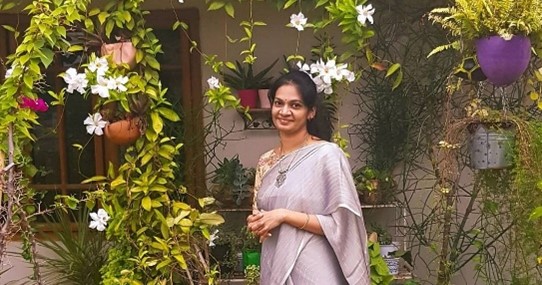
Smart ways that Madhuri adopted
- Madhavi made organic farming a household name in Andhra Pradesh by posting over 300 tutorial videos on ‘Mad Garden’, her Youtube channel with a family of 4,84,000 subscribers, and growing.
- Through her channel, she is trying propagate that gardening is just as easy as it looks, and anybody can do it.
- While the bulk of Madhavi’s videos are ‘how-tos’ on organic farming methods for growing different crops, Madavi also shares tips to combat pest control and on using natural fertilisers.
- She has also been growing about half of my vegetables over composting bins. If done right, this method not only nourishes the plant but also helps combat maggots, fruit flies and other harmful insects.
- She has been saving and using the seeds from her own plants, and stopped buying them altogether.
- She has also won an award in the category of terrace gardening by Rythu Nestham, an agricultural magazine that introduces farmers to new methods of organic farming.
Quote: “Agriculture is our wisest pursuit, because it will in the end contribute most to real wealth, good morals, and happiness.” — Thomas Jefferson
Source:
Share the article
Get Latest Updates on Offers, Event dates, and free Mentorship sessions.

Get in touch with our Expert Academic Counsellors 👋
FAQs
UPSC Daily Current Affairs focuses on learning current events on a daily basis. An aspirant needs to study regular and updated information about current events, news, and relevant topics that are important for UPSC aspirants. It covers national and international affairs, government policies, socio-economic issues, science and technology advancements, and more.
UPSC Daily Current Affairs provides aspirants with a concise and comprehensive overview of the latest happenings and developments across various fields. It helps aspirants stay updated with current affairs and provides them with valuable insights and analysis, which are essential for answering questions in the UPSC examinations. It enhances their knowledge, analytical skills, and ability to connect current affairs with the UPSC syllabus.
UPSC Daily Current Affairs covers a wide range of topics, including politics, economics, science and technology, environment, social issues, governance, international relations, and more. It offers news summaries, in-depth analyses, editorials, opinion pieces, and relevant study materials. It also provides practice questions and quizzes to help aspirants test their understanding of current affairs.
Edukemy's UPSC Daily Current Affairs can be accessed through:
- UPSC Daily Current Affairs can be accessed through Current Affairs tab at the top of the Main Page of Edukemy.
- Edukemy Mobile app: The Daily Current Affairs can also be access through Edukemy Mobile App.
- Social media: Follow Edukemy’s official social media accounts or pages that provide UPSC Daily Current Affairs updates, including Facebook, Twitter, or Telegram channels.


